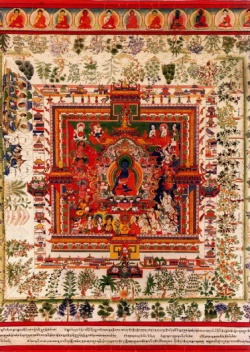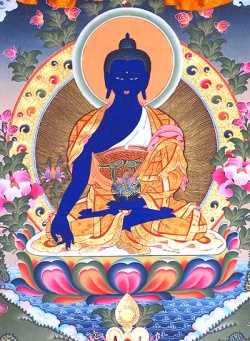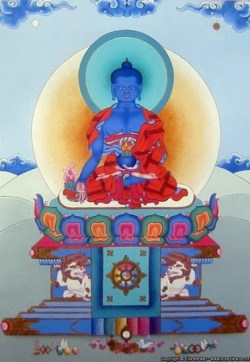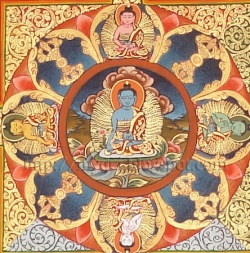The Mandala of the Medicine Buddha -Menla
according to the "ATLAS OF TIBETAN MEDICINE" from the Museum of History in Ulan Ude.
by Dr. Natalia D. Bolsokhoyeva (Ulan-Ude, Russia)
The "Atlas of Tibetan Medicine" or "Tibetan Medical Thankas" is preserved in the museum of history in ulan-Ude. This set, includes 76 colour thankas, is a copy which illustrates the subject of the Tibetan Medicine, theoretical as well as practical propositions of the unique system of medical science (gso rig-pa) of Tibet.
At sman rtsi Khang (Official name: the Hospital of Tibetan Autonomous Region) in Lhasa there is the original set of the "Tibetan Medical Thankas. Last November (1991) the author of this article got the unique opportunity to visit Lhasa's Smanrtsi Khang and had the opportunity to see the full set of the " Tibetan Medical Thankas", consisting of eighty tables. This set is the most excellent monument of medicine and Art of the medieval Tibet.
The first table of " Atlas of Tibetan medicine" from the museum of History in Ulan-Ude is the Mandala of rhe medicine Buddha -Menla. Some Scholars Prefer to call this Mandala as "The [[Medicine Mandala]Tanatuk]] (Blta-na sdug)." Tantuk is the name of Medicine Paradise, In this paradise Buddha as the medicine Buddha-Vaidurya had taught the classical treatise on traditional Tibetan medicine populary known as "Gyu-Zhi" "four Medical Tantras," consisting of four volumes, having 156 chapters in total.
1. This article is based on the lecture delivered by the author at the Ethnographical museum of Zurich University ({{Volkirkundemuseum der Universitat Zurich]]) during her scientific work in Switzerland in May 1992.
2. In this set of Ulan-Ude 62 tables are missing, concerning the diagnosis through observing detail changes Urine.
3. This set was published two times in China, the first edition is Tibetan-Chinese and the second one in Tibetan-English.
4. This explanation of the Mandala of the medicine Buddha-Menla is based on the text of "Gyu-bzhi" (zgyud-Bzhi), for the correct, conception of the description of this Mandala the author is obliged to use the full commentaries on "Gyu-bzhi", having the short title "Vaidurya sNgon-po' consisting of four volumes.
Any one who likes to meditate, and who wishes a long Life, as geed health, Happiness and to attain Nirvana Should l learn the science of Medicin, Menla at the <Medicine paradise- Tanatuc projects two emanations.
The first one is:
Rigpai Yeshe (Rig-pa'i Ye-Shes), an emanation of the Mind of the Medicine Buddha;
the second one is Yidlas Keys (yidlas skyes), an emanation of the speech of the Medicine Buddha, the
theoretical and practical propositions of the main medical treatise "Gyu-zhi" were given by the emanation of Rigpai Yeshe to Yidlas Kyes in the Form of a dialogue. The gods, rishis, Buddhists, non-Buddhists and even laymen had heard about the teaching of the medicine Buddha-Menla. However all of them understood it according to their individual Knowledge, and capabilities. They compiled a large number of medical Books on
what they had heard. Only Yiklas Kyes understood this teaching thoroughly. 5,900 slokas were composed by him it appears they were written by vaidurya ink on gold leaves. An ancient legend narrates that the Dakinis kept them in their palace in Uddiyana.
Numerous Buddhism cosmological texts consisting of traditional Information state that Mt.Meru (Ri-rab) is in the center of the Mandala which pictures our Universe.
The Mandala of the Medicine Buddha has three levels of its interpretation and different planes, earthly and celestial on which it exists. The ancient legends mention that Tanatuk, the Medicine paradise, is situated on Mt. Meru, its Mystical situation being in the Universe. Its physical position of it can be identified as on north of Bodhgaya (rdo-rje Gdan), It is here that Lord Buddha, had attained Enlightenment some other view that it is a jungle of medicine (Medicinal herbs and plants) in Uddiyana, the Birht place of Padmasambhava, where Buddha had spent four years of his earthly Life.
In the Medicine Mandala, the first table of the" Atlas of Tibetan Medicine", The Buddha has been depicted as the medicine Buddha residing at the center of the Mandala. He is in a crystal palace located in the center of city, his throne is made from lapis lazuli (Vaidurya), He is dark blue ijn colour like the sky and sits in the full-Lotus Meditative posture. in the Tibetan Medical literature there is a popular legend
concerning with the colour of the medicine Buddha. Once while the medicine Buddha-Menla was moving from place to place, he suddenly was met by a travellers. That traveller was very much suprised to see a person with so strange an appearance and immediately asked him why his appearance was so dark and so unusual. Then the medicine Buddha replied to that traveller. "I have all kind of disease in my Body and it is therefore I have become so dark blue".
The medicine Buddha, residing at the center of this Mandala, holds begging bowl in his left hand, lying on his lap, his right hand holds Terminalia Che Bulaa Retz. (A-ru-Ra), the "great medicine" -myrobalaln. He has all marks of perfection and all signs of Beauty Characterizing all Buddha. He is attended by a number of gods, Rishis, Brahmans, Buddhist, non-Buddhists, the Protectors of medicine, and the three Protectors-Manjushri, Avalokitesvara, Vajrapani, the goddesses.
5 According to the Budddhist tradition Uddiyana is the birthplace of Indian Magician Padmasambhava, the founder of Tibetan Tantrism.
6 The most popular of the three great Bodhisattvas of the Mahayana Buddhism, Manjushri (Jam dpal dbyangs) Bodhisattva of Wisdom, personification of the Wisdom of the Buddhas-Avalokitesvara (spyan ras gzigs) bodhisaattva of Compassion and Disciple of The Buddha; Vajrapani (phyagna rdo _rje, phyag rdor or lag na rdo-rje) -Bodhisattva, who embodies the might and Power of all Buddhas.of medicine, his two closest disciples-Ananda and Sariputra and also the holders of the medicine lineage.
The crystal palace is supported by sixteen- thousand pillars, it is surrounded by balustrades platforms for Offering divinity the five walls, eight steps and four gates symbolizing traditional structure of Mandala. the Garden, all around this palace, is full of sweet fragrances of medical plants herbs, and varieties of incences. There are numerous kinds of peace-loving Animals-peacocks, ducks, parrots, elephant and bears.
Outside of this wonderful city are four medicine mountains located in the four parts of the World. In four medicine mountains a great number of medical plants are cultivated by the beautiful Yidtogma (Yid Thog-Ma), the incarnation of the goddess of medicine-Dud rtsi-ma (Bdud rtsi-ma).
In the east there is the mountain Ponadan (spas ngad Ldan) where a forest is full of myrobalan- "great medicine", this tree possesses all medicinal qualities and any part of it can be used for all four hundred and four diseases. Myrobalan contains all six tastes (sweet, sour, bitter, hot salty and puckery) and eight properties A(Light, heavy, cold, hot, sharp, dull, moist and dry).
The mountain Malaya (Ma-La-Ya) is situated in the west. The "Six good" (Bzang-drug) plants grow in the slopes of this mountain. These plants have an exclusive effective to maintain the Body, nutmeg is useful for diseases; clover for Heart diseases; saffron for the liver, big cardamon for the spleen; small cardamon for the kidney; and bamboo pitch for the lungs. According to Tibetan pharmacological texts "Six Good" plants bring good luck and Happiness to the people.
On the rocky parts of the mountain, called Malaya, there are five kinds of minerals I.e: gold, silver, copper, iron and lead which are extraordinarily helpful for fever. There are five kinds of quartz, five types of medicinal hot springs that are good for fever from a cold and the sulphur bring conducive for cold diseases.
A large number of medicinal stones and various kind of salts are on the cliffs of the mountain Malaya using special methods and technology, they are important ingredients for so many treatments conducted in Tibetan traditional medicine. The first is echoed with sweet songs of birds. Many kinds
7. Eight medicine Goddesses: Bdud rtsi - ma; Grub -pa'i lha -mo ; gje - mo; od -ldan; Smug - bsl; gdong khra - ma; mdangs - ldan]]; Rig Byed -ma.
8. Ananda (Kun - dga' -Bo) is one of Buddha's cousins.
9. Sariputra is one of the famous early disciples of Buddha
10. According to a classification of the main guide on the theory and practice of Tibetan Medicine "Gyu -Zhi" there are four hundred and four diseases. The Tibetans believe that " the supreme medicine" - myrobalan is the universal medicine, curing all types of the sickness. The medicine Buddha - Menla holds this medicine in his right hand.
11. Numerous Tibetan medical texts give accounts of various type of saffron. However the best Saffron. Pocessing maximum qualities for health is from Kashmir.
12. In a practice of the traditional Tibetan medicine all diseases are dividedinto two groups, disease of cold nature and disease of hot nature it is an important classification, it still plays a main roll in diagnosis, in principles of treatment and in prevention and cure of diseases.
of birds and Animals live in this forest. There are peacocks and Elephants, bears whose bile are used on a large scale for liver sickness and musk deers whose musk is an unique ingredient for various treatments for vital diseases.
In the north lies the mountain Gangchen (gangs chen) Himalayas. There are all kinds of medical plants that are useful for hot diseases. The famous plants are that of camphor, uloewoods, white sandalwood and gentian, All of them are used for the illness with fever. They have sweet and bitter tastes and possess bland properties.
In the south stands the mountain Bekche (Begs - byed). All medicine plants useful for cold diseases are abundant they are with hot Power. Among them are red sandalwood, and long pepper. They have sour and salty tastes and possess hot properties. All these plants can normalize the imbalance of cold.
The Mandala of Medicine Budddha - Menla in the first table of the "Atlas of Tibetan Medicine"
has three levels:
external,
internal
and absolute.
It should be practiced in order to realize these three levels. External level means devotion to the Medicine Buddha _ Offering the Mandala and the practice of medicine. Inner level means the tantric practice of identifying oneself with the medicine Buddha and one's World with the
energies of the pure medicine land. Absolute level means the ultimate realization of the oneself like the Medicine Buddha who continuously manifests the Healing Power. The Mandala practicing through such practices is to realize the Trikaya, the Buddha nature of Body, speech and Mind - action, radiance and Emptiness.
In the history of traditional Tibetan Medicine there are various types of the Medicine Mandala in this article however we have ventured rto introduce a description of the [[Mandala of the medicine Buddha 0- Menla according to the first table of the "Atlas of Tibetan Medicine" from historical museum in Ulan - Ude based on the original Tibetan sources, with the short titles "Gyu -Zhi" and "Vaidurya sangon - po"



